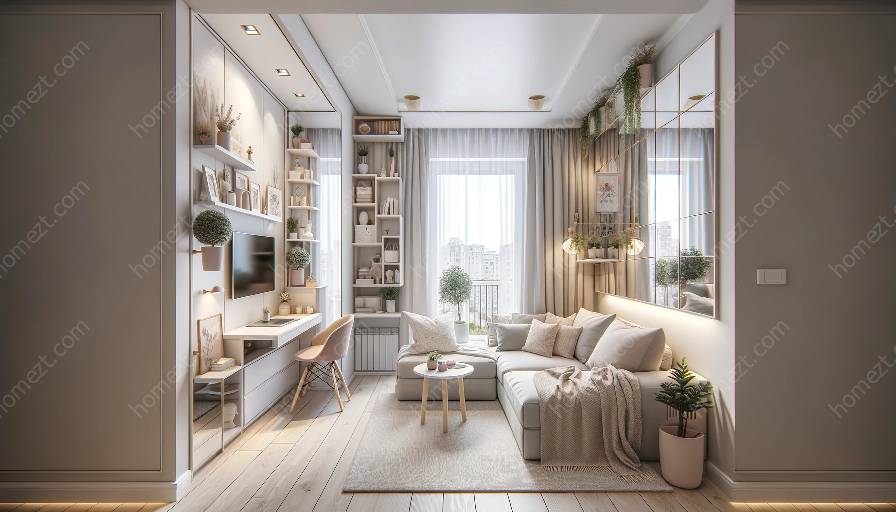Feng Shui is an ancient Chinese practice that involves arranging the environment to create harmony and balance. When it comes to small space design, applying Feng Shui principles can be particularly beneficial in creating a functional, comfortable, and aesthetically pleasing living area. In this article, we will explore how to incorporate Feng Shui into small space design while also addressing the art of utilizing small spaces and decorating.
Understanding Feng Shui Principles
Before delving into applying Feng Shui to small space design, it's important to understand the key principles of Feng Shui. Feng Shui revolves around the concept of Qi, often described as the energy flow that affects our well-being and success. By arranging your environment in accordance with Feng Shui principles, you can enhance the flow of Qi and promote harmony and balance in your living space.
The Bagua Map
A fundamental aspect of Feng Shui is the Bagua map, which is divided into nine areas representing different aspects of life, such as wealth, relationships, career, and health. Understanding the Bagua map can help you identify the areas of your small space that correspond to these aspects, allowing you to make changes to enhance the energy flow in each area.
Applying Feng Shui to Small Space Design
Now that you have a basic understanding of Feng Shui principles, let's explore how to apply them to small space design:
1. Declutter and Organize
Clutter disrupts the flow of energy and can create feelings of chaos and stress. In small spaces, clutter can quickly become overwhelming. Applying Feng Shui principles involves decluttering and organizing your space to promote a smooth flow of Qi. Consider storage solutions that keep items out of sight, such as hidden shelves and multifunctional furniture with built-in storage.
2. Balance and Harmony
Balance and harmony are essential in Feng Shui. In a small space, achieving balance can be challenging, but it is crucial for creating a harmonious environment. Use a mix of light and dark colors, incorporate elements of wood, fire, earth, metal, and water, and ensure that furniture and decor arrangements are well-proportioned to create a sense of equilibrium.
3. Utilize Natural Light and Air
Natural light and fresh air are important in Feng Shui for promoting positive energy flow. In small space design, maximizing natural light and ventilation can make the space feel more open and inviting. Consider using sheer curtains to allow natural light to filter in and strategically placing mirrors to reflect light and create the illusion of a larger space.
4. Incorporate Nature Elements
Bringing elements of nature into your small space can enhance the flow of positive energy. Consider incorporating houseplants, natural materials, and nature-inspired artwork to connect with the natural world and promote a sense of tranquility.
Utilizing Small Spaces
Utilizing small spaces effectively is essential for maximizing functionality and comfort. In addition to applying Feng Shui principles, consider the following tips for making the most of your small space:
1. Multipurpose Furniture
Select furniture that serves multiple functions to save space and optimize usability. Examples include a sofa bed, a drop-leaf table, or a storage ottoman that can also serve as a coffee table.
2. Vertical Storage
Make use of vertical space by adding shelves, wall-mounted cabinets, and hanging organizers. This not only creates additional storage but also draws the eyes upward, making the room feel more spacious.
3. Strategic Layout
Arranging furniture in a strategic layout can make a small space feel more open and functional. Consider creating designated zones for different activities, such as a reading nook, a workspace, or a dining area, to maximize the usability of the space.
Decorating with Feng Shui
Combining Feng Shui principles with effective decorating techniques can result in a visually appealing and harmonious small space. Consider the following tips for decorating with Feng Shui:
1. Use Calming Colors
Opt for calming and soothing colors that promote a sense of tranquility, such as soft blues, gentle greens, and earthy tones. These colors can help create a peaceful and relaxing atmosphere, in line with Feng Shui principles.
2. Mindful Placement of Art and Decor
When decorating with art and decor, be mindful of their placement in accordance with the Bagua map. For example, place artwork related to relationships in the corresponding area of the Bagua map, or use decor that represents wealth in the wealth area of your space.
3. Harmonize Textures and Fabrics
Incorporate a variety of textures and fabrics to create a tactile and inviting space. Soft fabrics, natural materials, and tactile elements can enhance the sensory experience and contribute to a harmonious ambiance.
Conclusion
Applying Feng Shui principles to small space design offers a holistic approach to creating a harmonious and functional living area. By understanding the key principles of Feng Shui, utilizing small spaces effectively, and decorating in line with Feng Shui guidelines, you can transform your small space into a balanced and aesthetically pleasing environment that supports your well-being and comfort.






































